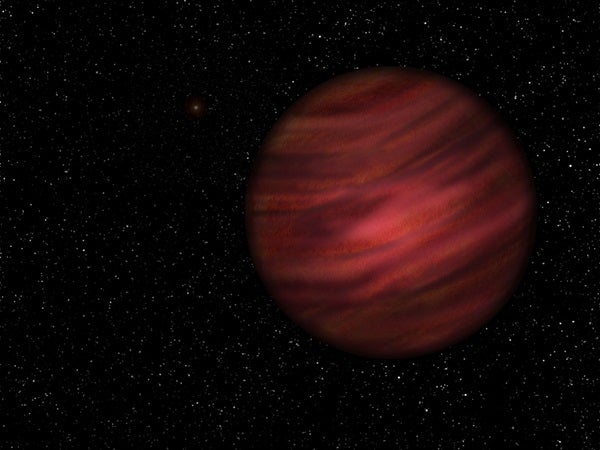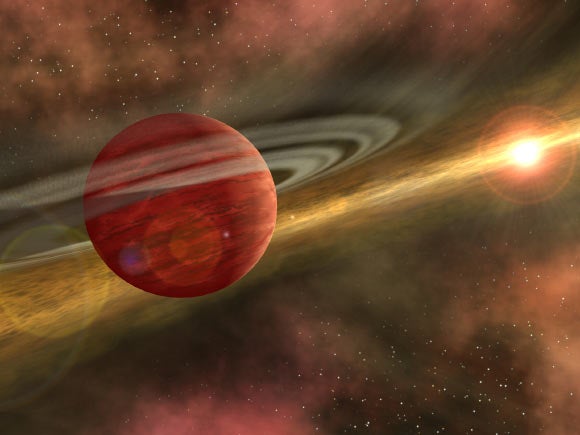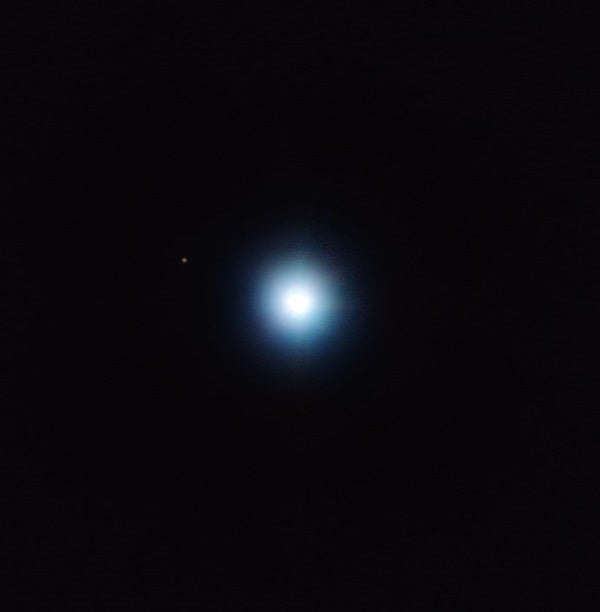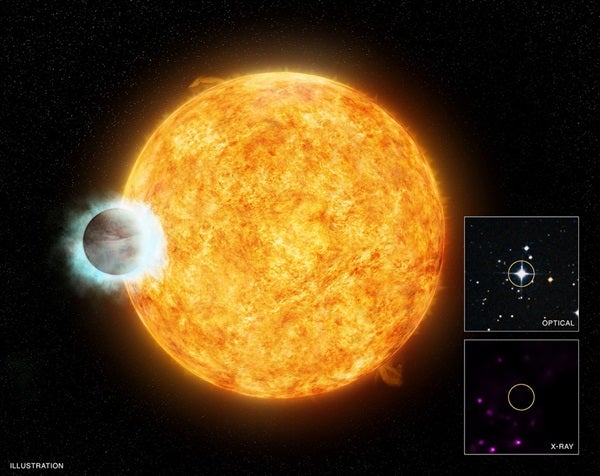These are the exoplanets your parents warned you about.
Nice, well-behaved planets orbit in the same direction as their star rotates, on a plane within a few degrees of the star’s equatorial plane. Mercury is pretty much the wildest planet in our solar system, with its 7⁰ orbital inclination. It turns out, though, that lots of planets like to behave wildly, with sharply titled orbits, orbits that stretch way out or insanely close to their parent stars. Some even have the nerve to orbit backwards. It’s a wild, wild galaxy full of exoplanets out there. Take a look.
The Million-Year Orbit
The gas giant 2MASS J2126-8140 has orbited its parent star only about 50 times since the birth of its solar system, 82 light years away in the constellation Octans. That’s because the planet orbits its star, the red dwarf TYC 9486-9271, at such a great distance that it takes about 900,000 years to complete a single orbit.
With 620 million miles of space between 2MASS J2126 and its star, astronomers thought for years that the gas giant was wandering through space all alone. That’s not an uncommon lifestyle for so-called brown dwarfs, gas giants that are technically too massive to be proper planets, but not quite massive enough to ignite and become stars. 2MASS J2126 is about 13 times as massive as Jupiter.
It’s highly unlikely that 2MASS J2126 is home to extraterrestrial life, but if it was, as the UK’s Royal Astronomical Society said in a statement, “any inhabitants would see their ‘Sun’ as no more than a bright star, and might not even imagine they were connected to it at all.”
TYC 9486-9271 is a young star, about the same age as 2MASS J2126, which lends credence to the idea that they’re actually part of the same solar system, despite the distance, and in 2016, astronomers worked out that the two were moving as if they shared a common center of gravity. That discovery made 2MASS J2126 the planet with the widest known orbit, replacing the previous contender, GU Piscium b, which, by comparison, zips around GU Piscium (a star in the constellation Pisces) in a speedy 163,000 years.
The Doomed Daredevil Planet
Kepler-432b’s orbit skims dangerously close to the dying giant that will one day swallow it whole, and as a result, astronomers say it has only about 200 million years left to live. Every 52 days, it passes within 24 million kilometers of the swelling star, as if taunting it, before swinging out to an aphelion of about 75 million kilometers. Kepler-432 is a slowly expanding red giant, and soon (in cosmic terms) it will swell to a large enough size to simply engulf the planet, which is six times as massive as Jupiter.
That’s the same fate that eventually awaits Earth, about 5 billion years from now. Our Sun will eventually burn up all the hydrogen fuel in its core and begin fusing helium instead. At the same time, its outer layers will begin to expand outward, eventually engulfing the inner solar system. That marks its transition from a yellow dwarf to a red giant, which will one day burn up all its helium fuel and collapse inward to become a white dwarf. Of course, by then it will be far, far too late for Earth.
It’s rare for astronomers to see a planet so close to a red giant star. Kepler-432b is one of just five exoplanets known to live in the dangerous real estate around expanding red giants. Most others have been found orbiting at a more prudent distance, further out in their star systems. After all, planets on daring orbits like Kepler-432b’s don’t last very long.
The Smallest, Fastest Orbits Around
Kepler-432b may be too close for comfort to its star, but some planets hug their parent stars so closely that it takes them just a matter of hours to complete an orbit. SWEEPS-10 takes just 10 hours to make a lap around its parent star, J175902.00−291323.7, a red dwarf star 22,000 light years away toward the central bulge of the Milky Way galaxy.
It’s part of a small category of exoplanets that astronomers call ultra-short-period planets, gas giants with orbital periods of less than one day. For comparison, Mercury takes about 88 days to complete one loop around the Sun. The USPPs nearly all orbit dwarf stars smaller than our Sun. SWEEPS-10’s star, for instance, is slightly less than half a solar mass, so the planet can survive at a cozy 1.2 million kilometers.
But the real winner in this category is 4,000 light years away in the constellation Serpens Cauda, orbiting a millisecond pulsar. PSR J1718-1438b orbits the pulsar at just 384,000 miles, whipping around in a full circle every 2.2 hours. With the same mass as Jupiter condensed into about two-fifths the space, it’s a ball of oxygen and crystalline carbon even denser than diamond, and astronomers say that it’s probably not technically a planet at all. Instead, a 2011 paper I the journal Science proposes, it’s probably actually a white dwarf: the burned-out core of a star that was once the pulsar’s companion in a binary system.
The Planet that Acts Like a Comet
Planets typically orbit their host stars in rounded ellipses, while comets follow long, narrow orbits that carry them far out into the cold reaches of the solar system before falling inward again. HD 20782b’s orbit looks more like that of a comet than a giant planet twice as massive as Jupiter. The gas giant slingshots around a G-type main sequence star 117 light years away in the constellation Fornax, swooping in just 5.5 million miles from the star (seven times closer than Mercury’s orbit of our Sun) before making a long swing 232 million miles out into its solar system (about the distance from the Sun to the Asteroid Belt). That gives HD 20782b an orbital eccentricity of 0.96: its path through space is a long, narrow ellipse, not the round, nearly circular kind that most well-behaved planets follow.
That wild orbit is probably thanks to a series of gravitational pushes from another gas giant orbiting the same star (which astronomers haven’t spotted yet), or possibly from the other star in its binary system, HD 20781. In fact, this is the first binary system astronomers have found where both stars have their own planets.
HD 20782b swoops past its star too fast for the stellar wind to blast away much of the gas giant’s atmosphere, so despite its daringly close perihelion, the planet still has clouds of icy particles, like the ones in Jupiter’s upper cloud layers. Starlight reflecting off those icy clouds allowed astronomers to learn more about the planet in 2016, ten years after changes in the star’s radial velocity first revealed the planet’s existence.
A Planetary Family Feud
A long time ago in a solar system 1,200 light years away,, two gas giants collided and flung each other to the far ends of the solar system. CVSO 30b, detected in 2012, orbits the young M3 star CVSO 30 at just 1.2 million kilometers, a tiny fraction of the distance between Mercury and the Sun. That’s right on the edge of its Roche limit, the distance at which the star’s gravity will start to rip the planet apart. In fact, CVSO 30b may already be close enough for its host star to start stripping away its mass. It takes just 11 hours for the gas giant to complete an orbit.
At the other end of the solar system, its sister planet CVSO 30c, detected in 2016, keeps its distance with a 99 billion kilometer orbital radius, taking 27,000 years to make a lap around the star. CVSO 30 is a fairly small star, less than half the mass of our Sun, so it’s unusual to find two super-sized gas giants caught in its gravitational pull. In fact, CVSO 30c is so large that its discoverers say it’s probably a type of brown dwarf, too large to be a proper planet and too small to become a star, hovering awkwardly on the threshold.
And given that the two planets are pretty close in mass (each is around 5 times as massive as Jupiter) their orbits shouldn’t be so wildly different, according to most models of how solar systems form. In fact, this is the first solar system astronomers have ever seen in which two planets have such different orbits.
CVSO 30c probably didn’t start its life so far from its parent star. In fact, it probably formed in a position more like the one Jupiter occupies in our own solar system, but at some point in the solar system’s history, 30b and 30c interacted gravitationally and flung each other into their current extreme orbits, in what astronomers described in a 2016 paper as “a mutual catastrophic event of planet-planet scattering.” It’s probably not stable in the long run – but for purposes of astronomers here on Earth, it’s close enough. That gives astronomers a rare opportunity to study what happens when gas giants interact.
The system may not be what it appears, however. A 2015 paper suggested that CVSO 30b might not exist at all. If that’s the case, CVSO 30c is so far out from CVSO 30 that it may not actually be orbiting the star at all. It could be a free-floating object in space, which isn’t uncommon for objects of its mass and type. So far, astronomical observations haven’t been able to confirm that the giant planet and the nearby star are actually moving regularly in relation to one another, so it’s possible that they’re simply not. On the other hand, astronomers say that’s highly unlikely, with odds on the order of .00002.
Hot Jupiter in a Death Spiral
WASP-18b is in a death spiral inward thanks to the gravitational pull of its parent star. another kind of daredevil planet. The gas giant races around its star once every 23 hours, a breakneck pace that’s faster than the star actually rotates.
“We appear to be seeing WASP-18b in a rare and short-lived state as it spirals towards its host star, destined to be destroyed within the host star’s lifetime,” wrote the authors of a 2009 paper in Nature announcing the discovery. That’s probably only going to take less than a million years, a cosmic blink of an eye. Because planets in WASP-18b’s situation are so short-lived, the odds of catching a planet during this brief phase are, well, astronomical.
But even as the star pulls the WASP-18b in toward its doom, the planet is fighting back. WASP-18b is so huge – about ten times as massive as Jupiter – that its tidal pull actually disrupts the star’s magnetic field. That keeps the star from emitting the energetic bursts of X-rays astronomers would normally expect from such a young star, and may even be affecting the star’s inner structure – in effect, prematurely aging it.
The Backwards Planets
Some planets’ orbits get tilted so steeply that they actually flip all the way over and end up orbiting their stars backwards, in what astronomers call a retrograde orbit. 1,040 light years away in the constellation Cygnus, one such rebellious planet, HAT-P-7b, orbits its star backwards.Its sister HAT-P-7c, meanwhile, is a perfectly normal, well behaved gas giant. But before you say, “HAT-P-7b, why can’t you be more like your sister?” keep in mind that HAT-P-7c may have actually put 7b on its current retrograde path. HAT-P-7B, a companion star to HAT-P-7, nudged HAT-P-7c into a steep orbit around HAT-P-7. Once 7c’s orbit was tilted enough, its gravity was able to push HAT-P-7b all the way over into a retrograde orbit.
There’s also WASP-17b, a particularly bloated Hot Jupiter, about twice Jupiter’s radius but only a fraction of its mass, racing the wrong way around an F-type main sequence star Wasp-17 1,000 light years away in the constellation Scorpius. Its discovery was announced the day before HAT-P-7-b. And astronomers know of at least seven other backward planets.
Astronomers find these backwards planets using the transit method. When astronomers are looking at a distant star, light on the side of the star that’s rotating toward Earth is blue-shifted, and light on the side that’s rotating away from Earth is red-shifted, in what’s called the Rossier-McLaughlin Effect. Normally when a planet transits its parent star, it blocks light from the blue-shifted side first, then the red-shifted side, and astronomers with telescopes here on Earth can record the change in the star’s light. A retrograde planet blocks the red-shifted light first, then the blue, giving away its backward behavior.
Following Wild Examples
Planets in other solar systems behave in strange ways. In fact, the more exoplanets astronomers discover, the more obvious it is that our solar system – with its planets all orbiting the same direction in more-or-less concentric ellipses – may actually be unusual in its sheer normalcy. But it turns out that we can learn a lot from all those wild exoplanets.
When astrophysicists discover an exoplanet on an extreme orbit, they work backward to figure out how it got there. Each crazy new orbit provides a little more insight into how gas giants in young solar systems interact with each other and their host stars. That, in turn, can shed some light on the history of our own solar system, helping us better understand why it looks the way it does.













